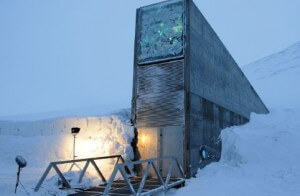Cultivating genetically uniform plant varieties may benefit farmers, but may also expose the plants to extinction. A seed bank in a remote town in the Arctic Circle is trying to prevent a disaster.

Cultivating genetically uniform plant varieties may benefit farmers, but may also expose the plants to extinction. A seed bank in a remote town in the Arctic Circle is trying to prevent a disaster.
In an abandoned salt mine not far from the North Pole, in a place called Svalbard, which is under the supervision of the Scandinavian countries, there is a treasure that the countries of the world have decided should be protected against catastrophes or global chaos. This mine, located deep in the earth, was chosen mainly due to low and stable temperature and humidity conditions that distinguish it and the treasure in the mine is a reservoir or garden bank of plants. In this bank, seeds of the wild plants that are the ancestors of the cultivated plants of the agricultural crops used for food and industry today, collected by botanical experts from different geographical areas, are kept.
The international effort, which ensures the collection and preservation of seeds containing the biological diversity of wild plants and cultivated crops, began already in the second half of the 20th century. International bodies in the United Nations and the World Food and Agriculture Organization invested a lot of resources and worked through international expert teams for the security of gene banks in the world. The need to collect and preserve the seeds arose from the disasters that befell world agriculture. For example, in the years 1845-1852, all the potato crops in Ireland were destroyed by a fungus, because only one variety of potato was grown throughout the country, which was not resistant to the fungus. This disaster caused a severe famine in Ireland known as the "Great Famine" and was, among other things, the reason for the large waves of immigration that hit the country. Another example is the destruction of all corn crops in the USA by the caterpillars of the corn borer. In this case, too, the variety of corn used by the farmers was genetically uniform and did not contain genes conferring resistance against the pest.
Even today, the aim of the cultivators of agricultural varieties is to obtain a uniform variety with properties suitable for the market requirements, such as a long shelf life. The result is that along with cultivation, strains are created with a reduced genetic load that loses properties and becomes vulnerable in unexpected situations. These examples illustrate the importance of preserving the genetic diversity found in nature, the result of long-term evolutionary selection that ensures the survival of the various biological species.
The global seed vault in Svalbard is welcome, but each country still needs to take care of preserving its ability to grow the food necessary for its existence. Here, the wild flora of the Land of Israel is very rich in its number of species, and many of them are the ancestors of the cultivated plants that are important to the global food supply. For example, in 1906, Aharon Aharonson recognized, near Rosh Pina in the Galilee, wild wheat, which is one of the sources of cultivated bread wheat and called it the mother of wheat. This finding was, of course, of global importance, and today the DNA of the mother of wheat serves as a genetic basis that enables the development of different and fine varieties of wheat using genetic engineering methods.
Indeed, in Israel, a gene bank for agricultural plants in Israel (wild plants and cultivated plants) was established, housed in the Directorate of Agricultural Research, in Beit Dagan. This reservoir and the herbarium named after Aharon Aharonson located at the University of Jerusalem are the bodies in charge of preserving and documenting the genetic diversity of the wild flora. The garden bank in Beit Dagan organizes expeditions whose role is to collect, clean and preserve seeds that are important for food and industrial crops in our region.
Besides the garden bank and the various collections scattered in Israel, there is a center for the Middle East established by the World Food and Agriculture Organization and based in Aleppo, Syria. Samples of seeds from Israel were also transferred to this center at the time. It is difficult to know what the fate of this institution is these days - it turns out that not only the forces of nature and unexpected catastrophes threaten the global food supply, but also destructive political developments.
___
on the notebook
Dr. Miriam Veldman served as senior head of the environment and regional R&D in the Ministry of Science and Technology and represented Israel in international committees on biological diversity issues.

2 תגובות
The Svalbard initiative is welcome, but not without problems.
It turns out that the seed deposit agreement includes a commitment by the repository to allow - in any case and in any situation - access to the seeds only to the depositor.
In other words - there was and will be a global catastrophe, only the big seed companies and the rich Western countries that deposited the seeds will be able to receive and trade them, instead of allowing, in such an extreme case, access to all of humanity.